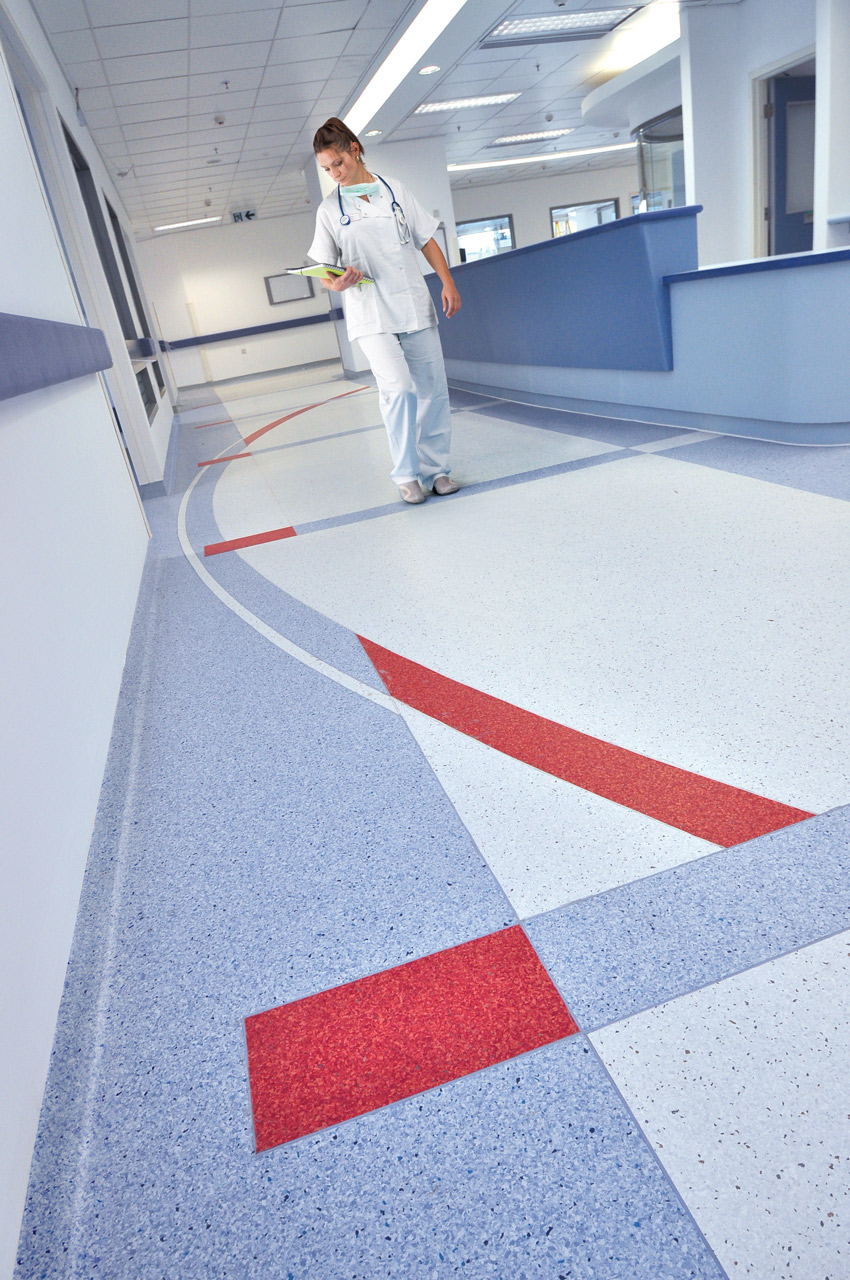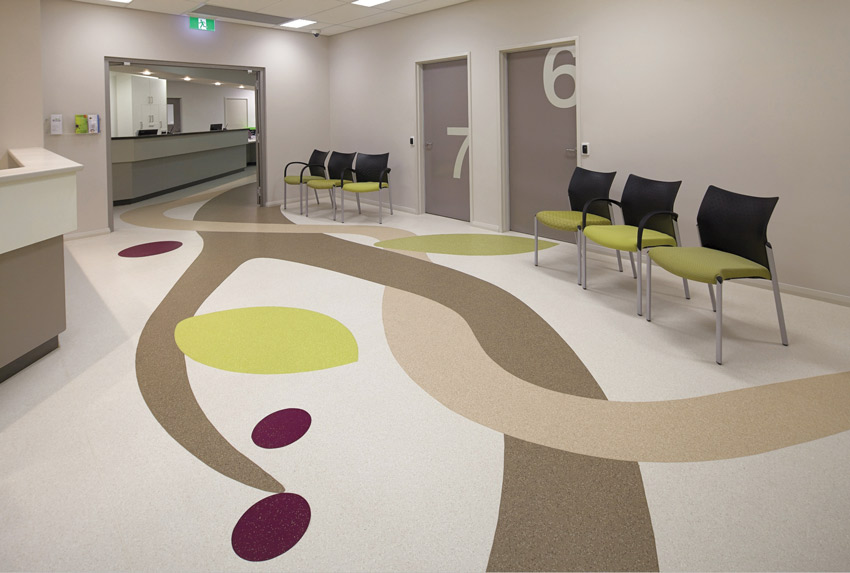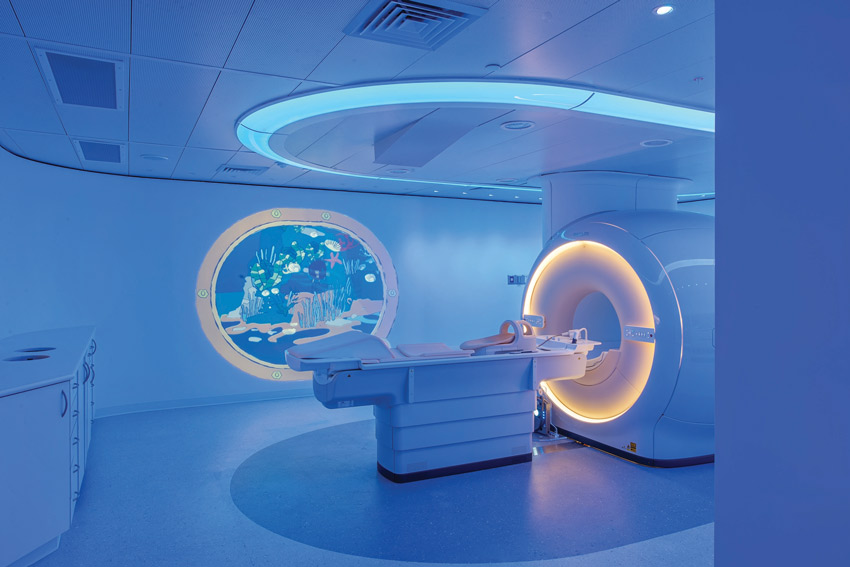Latest and Greatest Features in Linear Drains, Wall Coverings, and Flooring
Important Features in Health-Care Flooring
Technological advancements in flooring have transformed this interior finish from a simple underfoot surface to a solution that can help hospitals and health-care facilities achieve important performance goals, improve the overall patient experience, and offer a safer work environment for staff and visitors. Flooring today can help to protect indoor air quality, stop the spread of infection, manage sound, resist tough stains, and contribute to the level of cleanliness perceived by patients and staff.

Photo courtesy of Gerflor USA
Flooring today can help to protect indoor air quality, stop the spread of infection, manage sound, resist tough stains, and contribute to the level of cleanliness perceived by patients and staff.
Floorscore® Certified for Low VOC Emissions
Protecting the indoor air quality of hospitals is extremely important in designing interiors that promote health, healing, and well-being. When selecting flooring, a product’s emission levels of specific volatile organic compounds (VOCs) is a primary concern for designers hoping to maintain the integrity of their interior environment.
FloorScore® certification, managed by the Scientific Certification Systems (SCS), was developed to test and certify flooring products as being in compliance with the indoor air quality emission requirements adopted in California. The California standard, titled California Department of Public Health Standard Method for Testing and Evaluation of Volatile Organic Chemical Emissions from Indoor Sources Using Environmental Chambers, commonly referred to as CA 01350, has become the dominant standard for product emissions testing and is commonly referenced in rating systems and building codes.
Flooring products that bear the FloorScore seal have been independently certified to comply with the VOC emissions criteria of the CA 01350 standard and are deemed products that will contribute to good indoor air quality.
No-Wax Flooring
Vinyl composition tile (VCT) was once the standard flooring choice in health-care and education facilities. Although durable and good in high-traffic areas, these products required a rigorous strip, wax, and buff regimen to maintain their shiny and polished appearance and protect the floor. There are many notable disadvantages to this maintenance routine.
Floor stripping refers to the removal of old wax, soil, and debris found on the floor. The stripping process is both labor and time intensive, and it is common for even experienced cleaning professionals to make mistakes when stripping floors. Furthermore, the products used to wax and strip the floors often contain toxic VOCs, such as formaldehyde (a known carcinogen). A life-cycle study of flooring installation and maintenance found that the amount of VOCs emitted from a single waxing of a floor may be comparable to the amount of VOCs emitted from the flooring itself over its entire life.1 Floors regularly required this routine once or twice a year. The maintenance costs in time and attention were tremendous.
In response to the overwhelming need for a better flooring solution, manufacturers have developed flooring products that offer the shine and durability, without the use of wax. These no-wax floors are easier to maintain and are not stripped or waxed throughout the life of the product. Eliminating the use of the stripping agents and wax finishes, and the harmful chemicals they contain, is better for the overall indoor air quality of a hospital.
Antimicrobial
On any given day, about one in 25 hospital patients has at least one healthcare-associated infection (HAI), according to the Centers for Disease Control and Prevention (CDC). HAIs are infections that patients develop during the course of receiving health-care treatment. In 2011, there were an estimated 722,000 HAIs in U.S. acute-care hospitals, and roughly 75,000 patients with HAIs died during their hospitalizations.2 Prevention of the spread of these infections is critical to hospital performance and patient recovery.
Many manufacturers are now developing products with antimicrobial properties that inhibit the growth of the microorganisms responsible for causing these infections. The International Organization for Standardization (ISO) developed ISO 22196:2011, the internationally recognized test method for evaluating the antimicrobial activity of treated plastic materials.
Today, flooring is available that has been tested in accordance with the ISO 22196 method and found to inhibit the growth of 99 percent of bacteria, including E. coli, S. aureus, and MRSA.
Comfort Backing
Many of the flooring products found in health-care interiors contain multiple layers. For example, the thickness and type of wearlayer will provide durability and wear resistance. It could also have a surface treatment designed to provide stain resistance and a no-wax maintenance regimen. Other layers will provide color or patterned aesthetic, and fiberglass grids and a compact interlayer (or back layer) create the structure and support for the floor and provide resistance to indentation. Some floors also incorporate a layer referred to as a comfort backing. This layer is comprised of a very-high-density (VHD) foam. The addition of the comfort backing creates a floor that has some cushion or give to it.

Photo courtesy of Gerflor USA/Robert Frith
There are two primary benefits associated with the presence of comfort backing in a flooring product: improved comfort for staff spending long periods standing and noise control.
There are two primary benefits associated with the presence of comfort backing in a flooring product: improved comfort for staff spending long periods standing and noise control. The underfloor cushioning is often specified in areas like nursing stations to provide additional support and comfort where staff spend long hours on their feet. The VHD foam also imbues the flooring with sound management properties, enabling the floor to reduce the amount of sound that is created when an item is dropped on it or better control the sounds produced as staff, patients, and visitors walk on it. Better acoustic control improves the overall healing atmosphere of the hospital by making it more quiet and serene.
In fact, sound management has been identified as an important factor in gauging the overall patient experience in a hospital. The Hospital Consumer Assessment of Healthcare Providers and Systems (HCAHPS) is a patient satisfaction survey required by the Centers for Medicare and Medicaid Services (CMS) for all hospitals in the United States. Designed to provide an apples-to-apples comparison of hospitals throughout the country and increase the transparency of the quality of provided care, the results are published publicly. The survey encompasses nine key topics. Two of these components, acoustics and patient room cleanliness, can be directly impacted by design and construction.
Corridors are the origin of a significant amount of noise within health-care interiors. Specifying flooring with a comfort backing in hospital corridors will help to reduce the noise level that exists in these areas and assist in keeping corridor noise from entering patient rooms and disrupting the healing experience.
Excellent Stain Resistance
Interiors in the health-care environment need to not only be clean, they need to be perceived as clean. This means that the flooring should be free from visible stains and large scuff marks. Unfortunately, hospitals use many chemical solutions that can be incredibly staining, such as betadine, eosin, concentrated nitric acid, and iodine. There are also many items in a hospital that can cause scuff marks, from shoes to wheelchairs and the many wheeled carts pushed through the hospital daily.
In such a stain-intensive environment, the surface treatment of the flooring is designed to provide stain resistance and durability to keep the floor looking clean. Advancements in technology and technique continue to improve the strength and resistance of the flooring solutions available.
Various Levels of Contrast in Floor Design
The design of the flooring in a health-care interior must be matched to the unique needs of the specific space in which it is installed. It has been found that designs with a great degree of visual contrast or texture are readily perceived as cleaner surfaces and more successfully hide dirt and blemishes. Consider specifying high-contrast or textured designs in patient rooms and corridors to promote the perception of cleanliness and effectively camouflage the corridor areas that receive the greatest foot traffic. Other spaces, such as operating rooms, require low-contrasting designs on the floors to ensure that dropped tools or other items can be easily spotted and retrieved.

Photo courtesy of Gerflor USA
The design of the flooring in a health-care interior must be matched to the unique needs of the specific space in which it is installed.
Floor Coving
Another way to improve the overall cleanliness of the hospital interior is to cove the flooring at the room corners. Coving the flooring is not a new technique for floor installation, but new integrated floor-to-wall and corner systems are now available. These corner systems, as they are often referred to, use a specially cut piece of flooring that makes it possible to skip the process of corner welding.
A corner system completely eliminates tight and inaccessible corners from the interior space, leaving smooth and accessible slopes in their place. This has many advantages in a hospital application. It improves the cleanliness of room corners, reduces the opportunity for dirt and dust to buildup in these previously hard-to-reach places, and makes cleaning and maintenance in tight corner spaces easy and more efficient.
These clean corner systems can be incorporated into many different interior areas in a hospital. Patient rooms, operating rooms, and even cleanrooms will benefit from the elimination of hard-to-reach corners.
Notice

www.gerflorusa.com

www.infinitydrain.com

www.inprocorp.com









